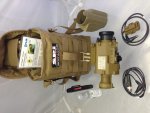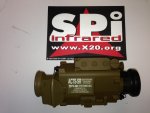Amber Filter
From what I have read, the T-70 series was designed for a Marine Corps contract specifically for the M-4 carbine using an ACOG? But apparently it incorporates other internal reticules for use on other equipment as well.
As regards to the T-60, I do like that platform very much, however more often than NOT it is way too bright and the manual adjustments for brightness display on the T-50 are extremely useful to me more often than not.
The T70 was not specifically optimized for the ACOG, the T60 was and initially as a joint effort with Trijicon. If you peel away the second layer of rubber cemented onto the T60 objective cover, you will see the Trijicon name and logo beneath. The ACOG is now being phased out of the JSOC baseline for peculiar equipment (PEQ) for the M4 Carbine. The T70 will still work with the ACOG, but is optimized for use with the day optic standard for the next evolution of the PEQ "block".
The reason why the default "set and forget" brightness of the FLIR T60 OLED is so high / intense is to facilitate use with ocular filters. The photo below, shows side-by-side comparisons of the FLIR T60 OLED as viewed through a Zeiss / Hensoldt day scope, one in the standard "black and white" and one with amber filter. Note how the amber filter cuts the blooming on the "white hot" image, improves the image contrast, and allows more image details to be detected. The amber filter also reduces eye fatigue and better preserves night-adjusted vision, while reducing backscatter of light emanating from the scope. These images, I feel are good for this demonstration of the benefits of amber filtering, as they were taken during conditions not optimum for thermal imaging: high relative humidity, with precipitation (rain), and 10-15 mph wind -- and which tend to create "white out" or "wash out" on thermal images.

The amber filter significantly improves visualization in white-hot mode, and is frequently used with thermal imaging systems employed by military and law enforcement.
The next set of images show the custom interface I've developed for ocular attachments to the day scopes used with the FLIR T60 or other clip-on thermal imager. It permits any filter, demist shield, or eye-piece that can be attached to the ocular of an AN/PVS-14 to be quickly attached or swapped on / off the ocular of most variable-power day scopes, and provides multiple options for addressing "light security," which is key for remaining covert in dark / low-light conditions.
In my opinion, there is much more that goes into the development of an effective weapons imaging system than just the clip-on optic. I think many shoooters can and should do a lot more than they are doing to extract maximum performance from their optic systems and equipment.
IR-V






